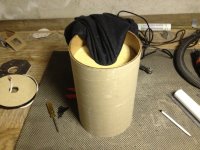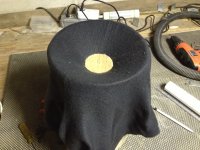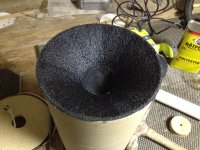-yes, low Rms important with low excursion. Also with respect to cabinet losses (like fiber fill).
I do NOT look for this with bass drivers.
I do NOT look for this with bass drivers.
The Beyma 12BR70 is also a good candidate for this. I designed (but did not build myself) a 80L cabinet with two ports of 75cm (3") of 22cm (8" 3/4) for a tuning to 40Hz with that driver. That one was crossed to a compression driver in horn at 1000Hz by the owner, and does work well that way.
Re: One of the most important pieces of spec is the Rms and Kms. For a driver to not hide low level detail, it will almost certainly (not always though) have low suspension resistance to movement. Suspension losses are ia huge detriment to low level detail and macro dynamics.
Is there good data to support this? I'd like to learn more.
From my understanding, the work of Klippel et. al have clarified that Kms is not a fixed number.
It is more accurately Kms(x)- mechanical stiffness of driver suspension as a function of displacement.
And sinceis the inverse of Kms, it follows too that Cms is better characterised as (x)- mechanical compliance of driver suspension as a function of displacement.
(x)- mechanical compliance of driver suspension as a function of displacement.
Intuitively we have probably known this to to be true for a long time, since Cms is a small signal parameter; measured at low signal levels (typically fractions of a volt), near the resonance frequency.
As you are aware- the– the mechanical resistance of the driver's suspension (i.e., 'lossiness') is related.
and since

then it follows that Qms is also better understood as Qm(s) - dependent on excursion.
Now none of this is surprising, because many people have been saying (?complaining) for decades that their measured Qts, Qes, Qmst's can vary quite widely from the quoted spec. Turns out the drive level affects your T/S parameter measurement.
I suspect that micro dynamics is related to what is happening at low volumes/low excursion eg. 1mm or less, and high SPL volumes/high excursion (eg. x-max /2 < excursion < x-max) respectively, and NOT something easily determined by looking at (static) frequency response measurements alone.
The Peerless NE315W was tested by Voice Coil in July 2010 IIRC, but I can't recall how well it performed on the Klippel, nor the appearance of the Kms(x) graph.
The manufacturer's specified Qms of 15 IS high, relativeto other woofers. The flatness and symmetry of the Kms (x) curve flatness may also be related to it's perceived acoustic behaviour.
I may try it investigate this driver before it is NLA. Did you have the 8ohm or 4 ohm variety? How big was your sealed box?
See this thread - https://www.diyaudio.com/community/threads/peerless-ne315w-08-for-a-3-way.340621/
I've used an 80 ltr sealed box for the NE315W-08 with good results. It has a very quiet motor and works well with higher crossover points ie 300+ Hz. The other choice is the SB34NRX75-6 for a sealed box. The SB34NRXL75-8 is better for a ported box. Both are great drivers with dead silent motors and suitable for higher xover points. I've used both crossed at 400Hz. They sound very natural and clean crossed that high.
Thinking about this a bit more... if the midrange is at 92.5 dB, the woofer will need to be up to 6 dB higher (98.5 dB/2.83V) to make up for the baffle step loss. Either you go (a lot) bigger than 8", use a very large box, or don't go low.1960s/1970s type of speaker. Big baffle. I need some advice on the woofer. I'm pretty sure the midrange I'll be using is 92.5dB/2.83v, so I'm looking for a highish efficiency woofer. I'd like 8", but...
With a 10" on both channels, we didn't need any baffle step adjustment, but I think a lot of it depends on room size (smallish-average living room) and how well it's coupled to the floor boundary. A squat box sitting on the floor may have a warmer mid-bass than a stand-mount or skinny column.
I've found that in most cases a 3dB higher sensitivity woofer will keep up with the midrange, given it sits closer to the floor for a bit of boundary reinforcement. Of course its better to have a more sensitive LF driver, which can be tamed easier with more BSC within reason.Thinking about this a bit more... if the midrange is at 92.5 dB, the woofer will need to be up to 6 dB higher (98.5 dB/2.83V) to make up for the baffle step loss. Either you go (a lot) bigger than 8", use a very large box, or don't go low.
In the past, I've used the WWMT configuration, so I have 2 x LF drivers of equal efficiency of one midrange, which gave me plenty of leeway for BSC thanks to extra gain of 2 drivers. You also have the option of running the upper LF driver a little further up to compensate for extra gain in the lower mids, sort of like a 2.5 way setup would have.
I built a large 4 way W-W-MB-M-T-MB for a friend with 2 x NE315W-08, 2x NE180W-08, 1x ScanSpeak D7608-9200 and 1x Morel CAT378. Woofers were each in 80 ltrs sealed sections and mids in 10 ltrs. Roughly recall running one LF section to 120 Hz 1st order branched off the other 300 Hz 2nd order to the upper LF. Midbass was cut at 850 Hz 2nd order on LP and HP. The Morel tweeter was crossed at 3400 Hz 2nd order elliptical, the same as the large SS dome to create a subtle BBC dip, which I prefer in most of my hifi purpose designs. I used a slight low shelf EQ on the LF to get bass extension down to 20 Hz -3dB. The enclosure was built in 2 sections to separate LF from the other section for the sake of easier handling, since this was a massive and heavy speaker. I built the crossover to be modular and capable of running from one channel or bi-amped.
This speaker had insane dynamic capability, specifically in the LF and midbass, yet sounded delicate and revealing all around. It would easily do 110+ dB peak and had 92 dB/W sensitivity. Specifically piano, vocals and acoustic music had a sense of realism, sounding like you were at the concert in the front row. Percusion had proper weight and size, which is hard to achieve on smaller designs. The texture, detail and authority in the LF and lower mids was better than anything I've heard with only exception to some horn loaded designs. The drivers blended so well together.
I unfortunately didn't find my notes on the crossover design, but I'll keep digging in hopes of wanting to build this design again for myself - it was that good. The crossover was huge, so it wasn't a simple design, but the outcome was well worth the effort. I really like large 4 way designs for the fact they can play every kind of music effortlessly. Sealed enclosure bass sounds so good. Once you hear it, you won't go back to sloppy ported box bass. Its also easier to integrate with the room. The best part is no sub needed.
Really? I am shocked, shocked! that a pair of NE315W's per side would provide enough bass... 😉The best part is no sub needed.
@mbrennwa
Agreed. Hence my earlier query to Augerpro- if one desires a specific sensitivity, one needs to determine cabinet size and to see what the extension is. OR, determine your desired extension and see what your required cabinet size is. Hoffman strikes again. But this isn’t Augerpro’s first rodeo. He knows all this. I suspect his friend isn’t firm on what size cabinet he wants. So he’s spitballing some ideas for currently available mids and woofers.
@profiguy
You provided the subjective translation to my old school speaker! I concur with everything you said.
Even though my old school speaker is only a 3 way.
830845x2 in 100L; Gen2 Kevlar FST in 8L, XTBG60



Slightly less old school:
SLS8”, SP1753 -

The difference in dynamic range is clear.
@augerpro
Go the big Vd !
Agreed. Hence my earlier query to Augerpro- if one desires a specific sensitivity, one needs to determine cabinet size and to see what the extension is. OR, determine your desired extension and see what your required cabinet size is. Hoffman strikes again. But this isn’t Augerpro’s first rodeo. He knows all this. I suspect his friend isn’t firm on what size cabinet he wants. So he’s spitballing some ideas for currently available mids and woofers.
@profiguy
This speaker had insane dynamic capability, specifically in the LF and midbass, yet sounded delicate and revealing all around. It would easily do 110+ dB peak and had 92 dB/W sensitivity. Specifically piano, vocals and acoustic music had a sense of realism, sounding like you were at the concert in the front row. Percusion had proper weight and size, which is hard to achieve on smaller designs. The texture, detail and authority in the LF and lower mids was better than anything I've heard with only exception to some horn loaded designs. The drivers blended so well together.
Sealed enclosure bass sounds so good. Once you hear it, you won't go back to sloppy ported box bass. Its also easier to integrate with the room. The best part is no sub needed.
You provided the subjective translation to my old school speaker! I concur with everything you said.
Even though my old school speaker is only a 3 way.
830845x2 in 100L; Gen2 Kevlar FST in 8L, XTBG60
Slightly less old school:
SLS8”, SP1753 -
The difference in dynamic range is clear.
@augerpro
Go the big Vd !
Last edited:
I was reading your post about that big speaker, and I was imagining how awesome it must have been to crank it up for the first time... and then your final line about no subwoofer needed made me laugh out loud. I would love to see a picture of it.Sarcasm can be sarcastic at times...
Hi hifijim,
ROTFLMAO.
https://www.google.com/url?sa=t&rct...usg=AOvVaw0OAtPrrpWiqTO4JMMbi_94&opi=89978449
Kindest regards,
M
Really? I am shocked, shocked! that a pair of NE315W's per side would provide enough bass... 😉
ROTFLMAO.
https://www.google.com/url?sa=t&rct...usg=AOvVaw0OAtPrrpWiqTO4JMMbi_94&opi=89978449
Kindest regards,
M
These caught my wandering HiFi eye:
https://faitalpro.com/en/products/LF_Loudspeakers/product_details/index.php?id=401005105
Unfortunately, I cannot find any distributors for this in the US. Like Thanh, I liked that it had a shorting ring compared to the rest of the line.
-yeah. 🙁
PE and US Speakers seem to be the distributors here, and nothing on their websites. I guess you could always email them for availability.
It does look like a very good driver; other than availability I wish it had a 90 Hz Fs with a bit more spl below 200 Hz. Mms & Rms look very good. I look at it and wonder about a large waveguide for it..
PE and US Speakers seem to be the distributors here, and nothing on their websites. I guess you could always email them for availability.
It does look like a very good driver; other than availability I wish it had a 90 Hz Fs with a bit more spl below 200 Hz. Mms & Rms look very good. I look at it and wonder about a large waveguide for it..
Mounting the 4fe42 from the back to a waveguide would definitely be fun and a nice fix to the basket being less than Hifi-looking.
A quick little test I did for a 3fe25 many years ago was to use stretched fabric (fleece) and impregnate it with polyester. As soon as the plastic of your choice (polyester, epoxy, polyurethane) hardens you have a semi rigid horn/waveguide that holds the shape well and can be reinforced from the inside.
And it could quite easily be scaled up. To get your desired shape you simply need to make a frame and insert shelves or “guidelines” that the fabric touches as it being stretched down towards the throat. Between the places the fabric touches a boundary it will form a straight section.
A quick little test I did for a 3fe25 many years ago was to use stretched fabric (fleece) and impregnate it with polyester. As soon as the plastic of your choice (polyester, epoxy, polyurethane) hardens you have a semi rigid horn/waveguide that holds the shape well and can be reinforced from the inside.
And it could quite easily be scaled up. To get your desired shape you simply need to make a frame and insert shelves or “guidelines” that the fabric touches as it being stretched down towards the throat. Between the places the fabric touches a boundary it will form a straight section.
Attachments
https://en.toutlehautparleur.com/speaker-faitalpro-4fe42-8-ohm-4-inch.htmlUnfortunately, I cannot find any distributors for this in the US. Like Thanh, I liked that it had a shorting ring compared to the rest of the line.
I’m sure I read somewhere that people from USA ordered from France without to much hassle. But the shipping is probably unreasonable on a relatively cheap driver.
Here is a possible woofer for a slightly lower sensitivity design - although it would be the same as the Beyma 8" I posted earlier: https://www.parts-express.com/Dayto...ference-Paper-Woofer-4-Ohm-295-569?quantity=1
If you are really interested, reach out to Parts Express and see if they will custom order it. I have custom ordered some things through them, so it is at least a possibility.Unfortunately, I cannot find any distributors for this in the US. Like Thanh, I liked that it had a shorting ring compared to the rest of the line.
There's nothing stopping you from ordering them from overseas, something many of us have to do almost every time we want a driver.Unfortunately, I cannot find any distributors for this in the US.
https://www.dibirama.altervista.org...-faital-4fe32-full-range-4-8-ohm-60-wmax.htmlDo you know of any 3rd-party measurements for this?
https://www.dibirama.altervista.org...tal-4fe32-16-full-range-4-16-ohm-60-wmax.html
- Home
- Loudspeakers
- Multi-Way
- Going old school



